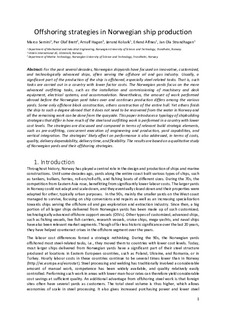Offshoring Strategies in Norwegian Ship Production
Semini, Marco; Brett, Per Olaf; Hagen, Arnulf; Kolsvik, Jørund; Alfnes, Erlend; Strandhagen, Jan Ola
Journal article, Peer reviewed
Accepted version
Permanent lenke
http://hdl.handle.net/11250/2492052Utgivelsesdato
2018Metadata
Vis full innførselSamlinger
Originalversjon
Journal of Ship Production and Design. 2018, 34 (1), 59-71. https://doi.org/10.5957/JSPD.160035Sammendrag
For the past several decades, Norwegian shipyards have focused on innovative, customized, and technologically advanced ships, often serving the offshore oil and gas industry. Usually, a significant part of the ship production is offshored, especially steel-related tasks. That is, such tasks are carried out in a country with lower factor costs. The Norwegian yards focus on the more advanced outfitting tasks, such as the installation and commissioning of machinery and deck equipment, electrical systems, and accommodation. Nevertheless, the amount of work performed abroad before the Norwegian yard takes over and continues production differs among various yards; some only offshore block construction, others construction of the entire hull. Yet others finish the ship to such a degree abroad that it does not need to be recovered from the water in Norway and all the remaining work can be done from the quayside. This paper introduces a typology of shipbuilding strategies that differ in how much of the steel and outfitting work is performed in a country with lower cost levels. The strategies are discussed and compared in terms of relevant build strategic elements, such as preoutfitting, concurrent execution of engineering and production, yard capabilities, and vertical integration. The strategies’ likely effect on performance is also addressed, in terms of costs, quality, delivery dependability, delivery time, and flexibility. The results are based on a qualitative study of Norwegian yards and their offshoring strategies.
